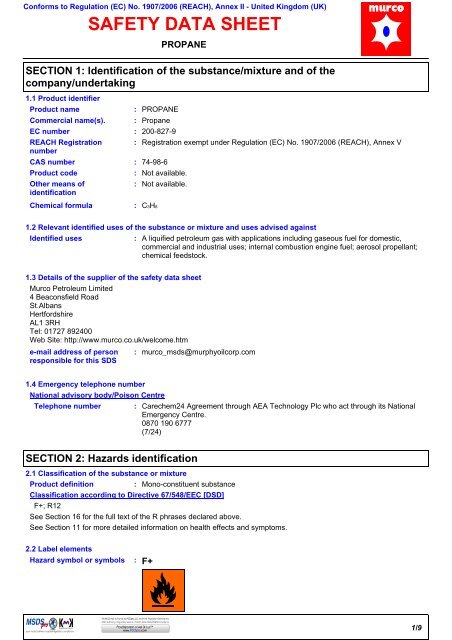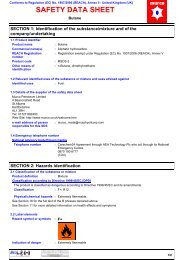SAFETY DATA SHEET - Murco Petroleum
SAFETY DATA SHEET - Murco Petroleum
SAFETY DATA SHEET - Murco Petroleum
Create successful ePaper yourself
Turn your PDF publications into a flip-book with our unique Google optimized e-Paper software.
Conforms to Regulation (EC) No. 1907/2006 (REACH), Annex II - United Kingdom (UK)<br />
<strong>SAFETY</strong> <strong>DATA</strong> <strong>SHEET</strong><br />
PROPANE<br />
SECTION 1: Identification of the substance/mixture and of the<br />
company/undertaking<br />
1.1 Product identifier<br />
Product name<br />
Other means of<br />
identification<br />
Chemical formula<br />
:<br />
:<br />
:<br />
PROPANE<br />
Commercial name(s). : Propane<br />
EC number : 200-827-9<br />
REACH Registration<br />
number<br />
CAS number : 74-98-6<br />
Product code<br />
: Registration exempt under Regulation (EC) No. 1907/2006 (REACH), Annex V<br />
: Not available.<br />
Not available.<br />
C3H8<br />
1.2 Relevant identified uses of the substance or mixture and uses advised against<br />
Identified uses<br />
: A liquified petroleum gas with applications including gaseous fuel for domestic,<br />
commercial and industrial uses; internal combustion engine fuel; aerosol propellant;<br />
chemical feedstock.<br />
1.3 Details of the supplier of the safety data sheet<br />
<strong>Murco</strong> <strong>Petroleum</strong> Limited<br />
4 Beaconsfield Road<br />
St.Albans<br />
Hertfordshire<br />
AL1 3RH<br />
Tel: 01727 892400<br />
Web Site: http://www.murco.co.uk/welcome.htm<br />
e-mail address of person<br />
responsible for this SDS<br />
:<br />
murco_msds@murphyoilcorp.com<br />
1.4 Emergency telephone number<br />
National advisory body/Poison Centre<br />
Telephone number : Carechem24 Agreement through AEA Technology Plc who act through its National<br />
Emergency Centre.<br />
0870 190 6777<br />
(7/24)<br />
SECTION 2: Hazards identification<br />
2.1 Classification of the substance or mixture<br />
Product definition<br />
: Mono-constituent substance<br />
Classification according to Directive 67/548/EEC [DSD]<br />
F+; R12<br />
See Section 16 for the full text of the R phrases declared above.<br />
See Section 11 for more detailed information on health effects and symptoms.<br />
2.2 Label elements<br />
Hazard symbol or symbols :<br />
F+<br />
1/9
Conforms to Regulation (EC) No. 1907/2006 (REACH), Annex II - United Kingdom (UK)<br />
PROPANE<br />
SECTION 2: Hazards identification<br />
Risk phrases<br />
Safety phrases<br />
Contains<br />
: Propane<br />
Supplemental label : Not applicable.<br />
elements<br />
Special packaging requirements<br />
Containers to be fitted<br />
with child-resistant<br />
fastenings<br />
Tactile warning of danger<br />
:<br />
:<br />
:<br />
:<br />
R12- Extremely flammable.<br />
S9- Keep container in a well-ventilated place.<br />
S16- Keep away from sources of ignition - No smoking.<br />
S33- Take precautionary measures against static discharges.<br />
Not applicable.<br />
Not applicable.<br />
2.3 Other hazards<br />
Substance meets the<br />
criteria for PBT according<br />
to Regulation (EC) No.<br />
1907/2006, Annex XIII<br />
: No.<br />
Substance meets the<br />
criteria for vPvB according<br />
to Regulation (EC) No.<br />
1907/2006, Annex XIII<br />
Other hazards which do not<br />
result in classification<br />
3.<br />
: Not available.<br />
:<br />
Not available.<br />
COMPOSITION/INFORMATION ON INGREDIENTS<br />
Substance/preparation<br />
Ingredient name<br />
:<br />
Mono-constituent substance<br />
CAS<br />
number<br />
Occupational exposure limits, if available, are listed in Section 8.<br />
% EC number Classification<br />
Propane 74-98-6 100 200-827-9 F+; R12 [A]<br />
Propylene 60 - 100 F+; R12<br />
Butane 60 - 100 F+; R12 [2]<br />
Ethylene 74-85-1 60 - 100 200-815-3 F+; R12<br />
R67<br />
[1] [2]<br />
See section 16 for the full text of the R-phrases<br />
declared above<br />
There are no additional ingredients present which, within the current knowledge of the supplier and in the<br />
concentrations applicable, are classified as hazardous to health or the environment and hence require reporting<br />
in this section.<br />
[1] Substance classified with a health or environmental hazard<br />
[2] Substance with a workplace exposure limit<br />
[3] PBT-substance<br />
[4] vPvB-substance<br />
SECTION 4: First aid measures<br />
4.1 Description of first aid measures<br />
Eye contact<br />
Skin contact<br />
Inhalation<br />
Ingestion<br />
:<br />
:<br />
:<br />
:<br />
Immediately flush eyes with plenty of water for at least 20 minutes, occasionally lifting<br />
the upper and lower eyelids.<br />
In case of contact, immediately flush skin with plenty of water for at least 20 minutes.<br />
Move exposed person to fresh air.<br />
As this product is a gas, refer to the inhalation section.<br />
4.2 Indication of any immediate medical attention and special treatment needed<br />
2/9
Conforms to Regulation (EC) No. 1907/2006 (REACH), Annex II - United Kingdom (UK)<br />
PROPANE<br />
SECTION 4: First aid measures<br />
Notes to physician<br />
Specific treatments<br />
:<br />
:<br />
Treat symptomatically. Contact poison treatment specialist immediately if large<br />
quantities have been ingested or inhaled.<br />
No specific treatment.<br />
SECTION 5: Firefighting measures<br />
5.1 Extinguishing media<br />
Suitable extinguishing<br />
media<br />
Unsuitable extinguishing<br />
media<br />
:<br />
:<br />
Use dry chemical or CO2.<br />
Do not use water jet.<br />
5.2 Special hazards arising from the substance or mixture<br />
:<br />
Hazardous combustion<br />
products<br />
Decomposition products may include the following materials:<br />
carbon dioxide<br />
carbon monoxide<br />
5.3 Advice for firefighters<br />
Special precautions for firefighters<br />
Special protective<br />
equipment for fire-fighters<br />
:<br />
:<br />
Promptly isolate the scene by removing all persons from the vicinity of the incident if<br />
there is a fire. Contact supplier immediately for specialist advice. Move containers<br />
from fire area if this can be done without risk. Use water spray to keep fire-exposed<br />
containers cool. If involved in fire, shut off flow immediately if it can be done without<br />
risk. If this is impossible, withdraw from area and allow fire to burn. Fight fire from<br />
protected location or maximum possible distance.<br />
Fire-fighters should wear appropriate protective equipment and self-contained<br />
breathing apparatus (SCBA) with a full face-piece operated in positive pressure<br />
mode. Clothing for fire-fighters (including helmets, protective boots and gloves)<br />
conforming to European standard EN 469 will provide a basic level of protection for<br />
chemical incidents.<br />
SECTION 6: Accidental release measures<br />
6.1 Personal precautions, protective equipment and emergency procedures<br />
For non-emergency<br />
personnel<br />
For emergency responders :<br />
:<br />
Accidental releases pose a serious fire or explosion hazard. No action shall be taken<br />
involving any personal risk or without suitable training. Evacuate surrounding areas.<br />
Keep unnecessary and unprotected personnel from entering. Shut off all ignition<br />
sources. No flares, smoking or flames in hazard area. Avoid breathing gas. Provide<br />
adequate ventilation. Wear appropriate respirator when ventilation is inadequate. Put<br />
on appropriate personal protective equipment.<br />
If specialised clothing is required to deal with the spillage, take note of any information<br />
in Section 8 on suitable and unsuitable materials. See also the information in "For<br />
non-emergency personnel".<br />
6.2 Environmental<br />
precautions<br />
:<br />
Ensure emergency procedures to deal with accidental gas releases are in place to<br />
avoid contamination of the environment. Inform the relevant authorities if the product<br />
has caused environmental pollution (sewers, waterways, soil or air).<br />
6.3 Methods and materials for containment and cleaning up<br />
Small spill : Immediately contact emergency personnel. Stop leak if without risk. Use spark-proof<br />
tools and explosion-proof equipment.<br />
Large spill<br />
:<br />
Immediately contact emergency personnel. Stop leak if without risk. Use spark-proof<br />
tools and explosion-proof equipment.<br />
6.4 Reference to other<br />
sections<br />
:<br />
See Section 1 for emergency contact information.<br />
See Section 8 for information on appropriate personal protective equipment.<br />
See Section 13 for additional waste treatment information.<br />
3/9
Conforms to Regulation (EC) No. 1907/2006 (REACH), Annex II - United Kingdom (UK)<br />
PROPANE<br />
SECTION 7: Handling and storage<br />
The information in this section contains generic advice and guidance. The list of Identified Uses in Section 1 should be<br />
consulted for any available use-specific information provided in the Exposure Scenario(s).<br />
7.1 Precautions for safe handling<br />
Protective measures :<br />
Advice on general<br />
occupational hygiene<br />
:<br />
Put on appropriate personal protective equipment (see Section 8). Contains gas<br />
under pressure. Avoid contact with eyes, skin and clothing. Avoid breathing gas. Use<br />
only with adequate ventilation. Wear appropriate respirator when ventilation is<br />
inadequate. Do not enter storage areas and confined spaces unless adequately<br />
ventilated. Store and use away from heat, sparks, open flame or any other ignition<br />
source. Use explosion-proof electrical (ventilating, lighting and material handling)<br />
equipment. Use only non-sparking tools. Empty containers retain product residue<br />
and can be hazardous. Do not puncture or incinerate container.<br />
Eating, drinking and smoking should be prohibited in areas where this material is<br />
handled, stored and processed. Workers should wash hands and face before eating,<br />
drinking and smoking. Remove contaminated clothing and protective equipment<br />
before entering eating areas. See also Section 8 for additional information on hygiene<br />
measures.<br />
7.2 Conditions for safe<br />
storage, including any<br />
incompatibilities<br />
:<br />
Store in accordance with local regulations. Store in a segregated and approved area.<br />
Store away from direct sunlight in a dry, cool and well-ventilated area, away from<br />
incompatible materials (see section 10). Eliminate all ignition sources. Keep<br />
container tightly closed and sealed until ready for use.<br />
7.3 Specific end use(s)<br />
Recommendations :<br />
Industrial sector specific<br />
solutions<br />
:<br />
Not available.<br />
Not available.<br />
SECTION 8: Exposure controls/personal protection<br />
The information in this section contains generic advice and guidance. The list of Identified Uses in Section 1 should be<br />
consulted for any available use-specific information provided in the Exposure Scenario(s).<br />
8.1 Control parameters<br />
Occupational exposure limits<br />
Product/ingredient name<br />
Exposure limit values<br />
Propane<br />
Recommended monitoring<br />
procedures<br />
:<br />
Oxygen Depletion [Asphyxiant]<br />
If this product contains ingredients with exposure limits, personal, workplace<br />
atmosphere or biological monitoring may be required to determine the effectiveness<br />
of the ventilation or other control measures and/or the necessity to use respiratory<br />
protective equipment. Reference should be made to European Standard EN 689 for<br />
methods for the assessment of exposure by inhalation to chemical agents and<br />
national guidance documents for methods for the determination of hazardous<br />
substances.<br />
8.2 Exposure controls<br />
Appropriate engineering<br />
controls<br />
Individual protection measures<br />
Hygiene measures :<br />
Eye/face protection :<br />
Skin protection<br />
:<br />
Use only with adequate ventilation. Use process enclosures, local exhaust ventilation<br />
or other engineering controls to keep worker exposure to airborne contaminants<br />
below any recommended or statutory limits. Use explosion-proof ventilation<br />
equipment.<br />
Ensure that eyewash stations and safety showers are close to the workstation<br />
location. Wash hands, forearms and face thoroughly after handling chemical<br />
products, before eating, smoking and using the lavatory and at the end of the working<br />
period.<br />
Safety eyewear should be used when there is a likelihood of exposure.<br />
Recommended: Chemical splash goggles.<br />
4/9
Conforms to Regulation (EC) No. 1907/2006 (REACH), Annex II - United Kingdom (UK)<br />
PROPANE<br />
SECTION 8: Exposure controls/personal protection<br />
Hand protection<br />
Body protection :<br />
Other skin protection<br />
Respiratory protection :<br />
Environmental exposure<br />
controls<br />
Flash point<br />
Solubility(ies)<br />
:<br />
:<br />
:<br />
SECTION 9: Physical and chemical properties<br />
9.1 Information on basic physical and chemical properties<br />
Appearance<br />
Physical state<br />
Colour<br />
:<br />
:<br />
Gas or liquefied gas.<br />
Colourless.<br />
Odour<br />
: Typical<br />
pH<br />
: Not soluble in water.<br />
Melting point/freezing point<br />
Initial boiling point and boiling<br />
range<br />
:<br />
:<br />
-189°C<br />
-45°C<br />
Use gloves appropriate for work or task being performed. Recommended: Leather<br />
gloves.<br />
Personal protective equipment for the body should be selected based on the task<br />
being performed and the risks involved and should be approved by a specialist<br />
before handling this product. Recommended: Overalls.<br />
Appropriate footwear and any additional skin protection measures should be selected<br />
based on the task being performed and the risks involved and should be approved by<br />
a specialist before handling this product. Flame-resistant antistatic protective clothing.<br />
Respirator selection must be based on known or anticipated exposure levels, the<br />
hazards of the product and the safe working limits of the selected respirator. Ensure<br />
an MSHA/NIOSH-approved respirator or equivalent is used.<br />
Emissions from ventilation or work process equipment should be checked to ensure<br />
they comply with the requirements of environmental protection legislation.<br />
Evaporation rate : >1 (ether (anhydrous) = 1)<br />
Flammability<br />
: Extremely flammable in the presence of the following materials or conditions:<br />
open flames, sparks and static discharge.<br />
Highly flammable in the presence of the following materials or conditions: heat.<br />
Upper/lower flammability or : Lower: 2.2%<br />
explosive limits<br />
Upper: 9.2%<br />
Vapour pressure<br />
Vapour density<br />
:<br />
:<br />
1039.9 to 1133.2 kPa [20°C]<br />
1.4 to 1.55 [Air = 1]<br />
Relative density<br />
: 0.59<br />
Specific gravity : 0.59 g/cm 3<br />
Auto-ignition temperature<br />
Viscosity<br />
:<br />
:<br />
:<br />
:<br />
Closed cup: -105°C [Pensky-Martens.]<br />
Insoluble<br />
450°C<br />
Not applicable.<br />
9.2 Other information<br />
No additional information.<br />
SECTION 10: Stability and reactivity<br />
10.1 Reactivity : No specific test data related to reactivity available for this product or its ingredients.<br />
10.2 Chemical stability :<br />
The product is stable.<br />
10.3 Possibility of hazardous<br />
reactions<br />
: Under normal conditions of storage and use, hazardous reactions will not occur.<br />
10.4 Conditions to avoid : Avoid all possible sources of ignition (spark or flame). Do not pressurise, cut, weld,<br />
braze, solder, drill, grind or expose containers to heat or sources of ignition.<br />
5/9
Conforms to Regulation (EC) No. 1907/2006 (REACH), Annex II - United Kingdom (UK)<br />
PROPANE<br />
SECTION 10: Stability and reactivity<br />
10.5 Incompatible materials :<br />
Nitric acid, nitrogen dioxide, sulphuric acid and oxidising agents.<br />
10.6 Hazardous<br />
decomposition products<br />
:<br />
Decomposition products may include the following materials:<br />
carbon oxides<br />
SECTION 11: Toxicological information<br />
11.1 Information on toxicological effects<br />
Acute toxicity<br />
Aspiration hazard<br />
Not available.<br />
Information on the likely<br />
routes of exposure<br />
:<br />
Routes of entry anticipated:Dermal, Inhalation.<br />
Potential acute health effects<br />
Inhalation<br />
Ingestion<br />
Skin contact<br />
Eye contact<br />
: No known significant effects or critical hazards.<br />
: As this product is a gas, refer to the inhalation section.<br />
: Contact with rapidly expanding gas may cause burns or frostbite.<br />
: Contact with rapidly expanding gas may cause burns or frostbite.<br />
Symptoms related to the physical, chemical and toxicological characteristics<br />
Inhalation<br />
Ingestion<br />
Skin contact<br />
Eye contact<br />
: May cause symptoms of oxygen deficiency, leading to loss of consciousness if<br />
exposure continues.<br />
: No specific data.<br />
: No specific data.<br />
: No specific data.<br />
Delayed and immediate effects and also chronic effects from short and long term exposure<br />
Short term exposure<br />
Potential immediate<br />
effects<br />
:<br />
Not available.<br />
Potential delayed effects :<br />
Long term exposure<br />
Potential immediate<br />
effects<br />
:<br />
Not available.<br />
Not available.<br />
Potential delayed effects : Not available.<br />
General : No known significant effects or critical hazards.<br />
Carcinogenicity : No known significant effects or critical hazards.<br />
Mutagenicity : No known significant effects or critical hazards.<br />
Teratogenicity : No known significant effects or critical hazards.<br />
Developmental effects : No known significant effects or critical hazards.<br />
Fertility effects<br />
: No known significant effects or critical hazards.<br />
Other information : Not available.<br />
SECTION 12: Ecological information<br />
12.1 Toxicity<br />
Product/ingredient name Result<br />
Species<br />
Exposure<br />
Propane LC50 >1000 mg/l Fish 96 hours<br />
Remarks<br />
: Not available.<br />
12.2 Persistence and degradability<br />
Remarks<br />
: Not available.<br />
6/9
Conforms to Regulation (EC) No. 1907/2006 (REACH), Annex II - United Kingdom (UK)<br />
PROPANE<br />
SECTION 12: Ecological information<br />
12.3 Bioaccumulative potential<br />
Not available.<br />
12.4 Mobility in soil<br />
Soil/water partition<br />
coefficient (KOC)<br />
Mobility<br />
:<br />
:<br />
Not available.<br />
Not available.<br />
12.5 Results of PBT and vPvB assessment<br />
PBT<br />
: No.<br />
vPvB<br />
: Not available.<br />
12.6 Other adverse effects : No known significant effects or critical hazards.<br />
SECTION 13: Disposal considerations<br />
The information in this section contains generic advice and guidance. The list of Identified Uses in Section 1 should be<br />
consulted for any available use-specific information provided in the Exposure Scenario(s).<br />
13.1 Waste treatment methods<br />
Product<br />
Methods of disposal<br />
Hazardous waste :<br />
Packaging<br />
Methods of disposal :<br />
Special precautions :<br />
SECTION 14: Transport information<br />
:<br />
The generation of waste should be avoided or minimised wherever possible.<br />
Significant quantities of waste product residues should not be disposed of via the foul<br />
sewer but processed in a suitable effluent treatment plant. Dispose of surplus and<br />
non-recyclable products via a licensed waste disposal contractor. Disposal of this<br />
product, solutions and any by-products should at all times comply with the<br />
requirements of environmental protection and waste disposal legislation and any<br />
regional local authority requirements.<br />
The classification of the product may meet the criteria for a hazardous waste.<br />
The generation of waste should be avoided or minimised wherever possible. Empty<br />
pressure vessels should be returned to the supplier. Waste packaging should be<br />
recycled. Incineration or landfill should only be considered when recycling is not<br />
feasible.<br />
This material and its container must be disposed of in a safe way. Empty containers<br />
or liners may retain some product residues. Do not puncture or incinerate container.<br />
ADR/RID ADN/ADNR<br />
IMDG IATA<br />
14.1 UN number<br />
UN1978<br />
UN1978<br />
UN1978<br />
UN1978<br />
14.2 UN proper<br />
shipping name<br />
PROPANE<br />
PROPANE<br />
PROPANE<br />
PROPANE<br />
14.3 Transport<br />
hazard class(es)<br />
2<br />
2<br />
2.1<br />
2.1<br />
14.4 Packing group<br />
-<br />
-<br />
-<br />
-<br />
14.5 Environmental<br />
hazards<br />
No. No. No. No.<br />
7/9
Conforms to Regulation (EC) No. 1907/2006 (REACH), Annex II - United Kingdom (UK)<br />
PROPANE<br />
SECTION 14: Transport information<br />
14.6 Special<br />
precautions for<br />
user<br />
Not available. Not available. Not available. Not available.<br />
Additional<br />
information<br />
Hazard identification<br />
number<br />
23<br />
Limited quantity<br />
LQ0<br />
CEFIC Tremcard<br />
20S1978<br />
- - Passenger and Cargo<br />
AircraftQuantity limitation:<br />
Forbidden<br />
Cargo Aircraft OnlyQuantity<br />
limitation: 150 kg<br />
PG* : Packing group<br />
Exemption to the above classification may apply.<br />
SECTION 15: Regulatory information<br />
15.1 Safety, health and environmental regulations/legislation specific for the substance or mixture<br />
EU Regulation (EC) No. 1907/2006 (REACH)<br />
Annex XIV - List of substances subject to authorisation<br />
Substances of very high concern<br />
None of the components are listed.<br />
Annex XVII - Restrictions<br />
on the manufacture,<br />
placing on the market and<br />
use of certain dangerous<br />
substances, mixtures and<br />
articles<br />
: Not applicable.<br />
Other EU regulations<br />
Europe inventory<br />
: This material is listed or exempted.<br />
Black List Chemicals : Not listed<br />
Priority List Chemicals : Not listed<br />
Integrated pollution : Not listed<br />
prevention and control list<br />
(IPPC) - Air<br />
Integrated pollution<br />
prevention and control list<br />
(IPPC) - Water<br />
: Not listed<br />
15.2 Chemical Safety<br />
Assessment<br />
:<br />
Not available.<br />
SECTION 16: Other information<br />
Abbreviations and acronyms<br />
Full text of abbreviated R<br />
phrases<br />
Full text of classifications<br />
[DSD/DPD]<br />
History<br />
Date of issue<br />
: 16/12/2010<br />
(dd/mm/yyyy)<br />
Version : 1<br />
: ATE = Acute Toxicity Estimate<br />
CLP = Classification, Labelling and Packaging Regulation [Regulation (EC) No.<br />
1272/2008]<br />
DNEL = Derived No Effect Level<br />
EUH statement = CLP-specific Hazard statement<br />
PNEC = Predicted No Effect Concentration<br />
RRN = REACH Registration Number<br />
:<br />
:<br />
R12- Extremely flammable.<br />
R67- Vapours may cause drowsiness and dizziness.<br />
F+ - Extremely flammable<br />
8/9
Conforms to Regulation (EC) No. 1907/2006 (REACH), Annex II - United Kingdom (UK)<br />
PROPANE<br />
SECTION 16: Other information<br />
Notice to reader<br />
To the best of our knowledge, the information contained herein is accurate. However, neither the above-named supplier, nor any of its<br />
subsidiaries, assumes any liability whatsoever for the accuracy or completeness of the information contained herein.<br />
Final determination of suitability of any material is the sole responsibility of the user. All materials may present unknown hazards and should<br />
be used with caution. Although certain hazards are described herein, we cannot guarantee that these are the only hazards that exist.<br />
9/9










